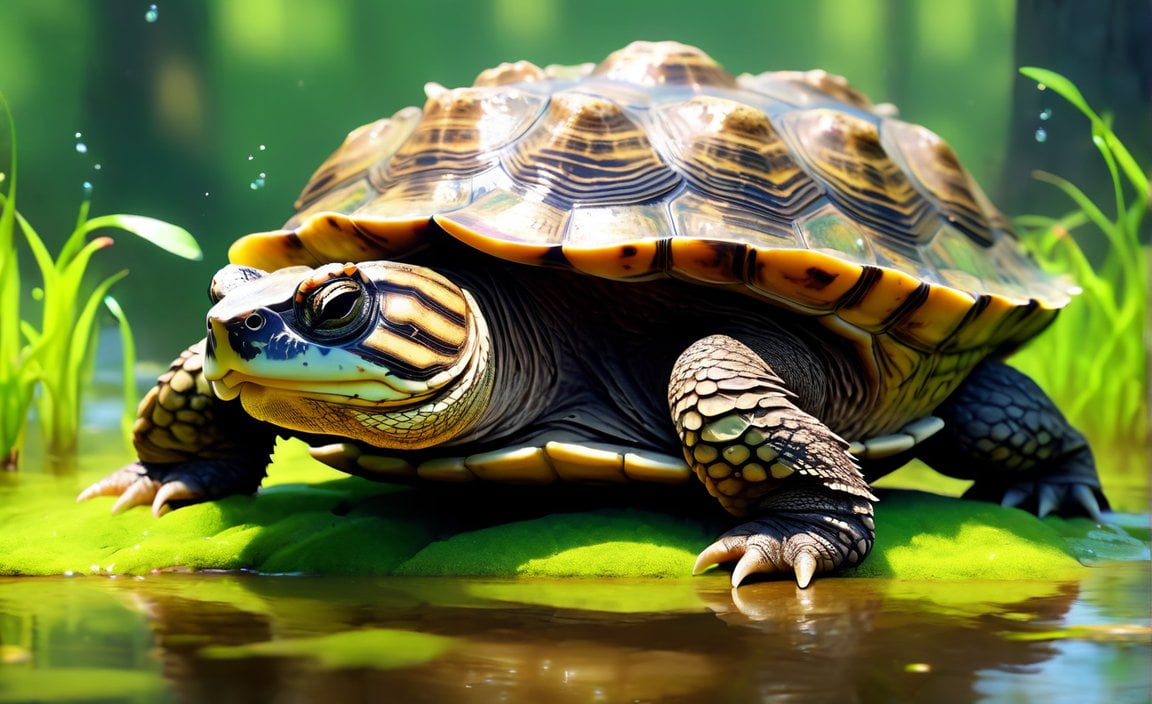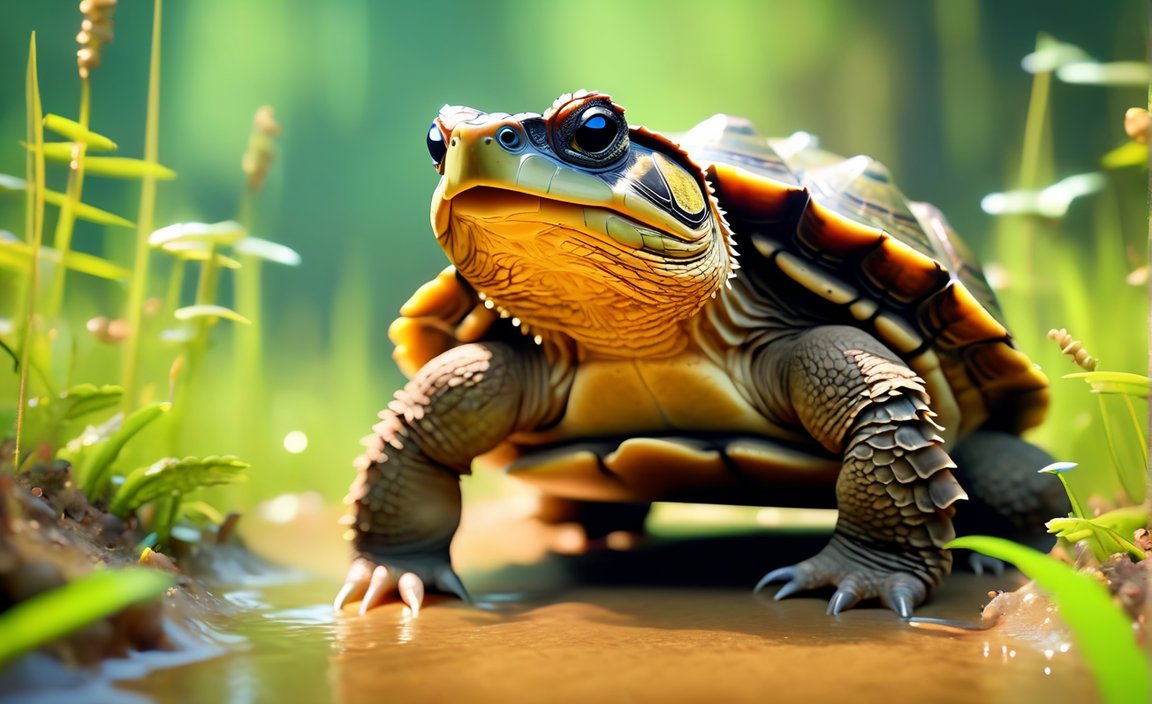Fascinating Insights: 10 Facts about Snapping Turtles

Delving into the world of snapping turtles reveals a wealth of captivating information about these ancient reptilian creatures. With their impressive size, formidable jaws, and unique adaptations, snapping turtles have captured the curiosity of scientists and nature enthusiasts alike. In this article, we will explore ten compelling facts about snapping turtles, shedding light on their extraordinary behaviors, remarkable abilities, and the crucial role they play in aquatic ecosystems. Get ready to embark on a fascinating journey of discovery into the captivating world of snapping turtles.
Key Takeaways:
- Snapping turtles are known for their relaxed nature and cannot retreat into their shells for protection.
- The sex of snapping turtles is determined by temperature, with warmer temperatures leading to females and cooler temperatures leading to males.
- Snapping turtles have a slow growth rate and can live for several decades.
- They are highly adapted for aquatic life and spend most of their time underwater.
- In New York State, snapping turtles are recognized as the official reptile.
- They can be hunted in some regions as they are considered a game species.
- Snapping turtles have a varied diet and can eat almost anything they come across.
- The alligator snapping turtle, a specific type of snapping turtle, has been known to live for up to 150 years.
10 Facts About Snapping Turtles
Snapping turtles are remarkable creatures that inhabit various aquatic ecosystems. These ancient reptiles have captured the curiosity and interest of researchers and nature enthusiasts alike. So, let’s dive into the fascinating world of snapping turtles and uncover some intriguing facts about these incredible creatures.
1. Snapping Turtles Like to Take it Easy
One interesting thing about snapping turtles is their relaxed nature. They often prefer to take it easy and can frequently be seen basking in the sun or lazily swimming in calm waters. This laid-back attitude is quite unique among turtles and adds to the charm of these fascinating reptiles.
2. Snapping Turtles Lack Shell Retreat Abilities
Unlike other turtles, snapping turtles cannot retreat into their shells for protection. Instead, they rely on their powerful jaws and sharp beaks to defend themselves from potential threats. Their strong bite force acts as a natural deterrent, making them formidable creatures in their habitat.
3. Temperature Determines the Sex of Snapping Turtles
The sex of snapping turtles is determined by temperature. Here, the age-old phrase “hot chicks and cool dudes” rings true. Warmer temperatures during incubation lead to the development of female snapping turtles, while cooler temperatures give rise to males. This unique aspect of their biology adds an interesting twist to the reproductive life of snapping turtles.
4. Slow and Steady Growth
Snapping turtles have a slow growth rate. Unlike other animals that rapidly reach maturity, these turtles take their time to grow up. Over several years, they gradually grow larger, offering an impressive example of how persistence and patience can lead to greatness.
5. Long Lifespan
Snapping turtles are known for their longevity. These remarkable reptiles can live for several decades, with some individuals even reaching the impressive age of 100 years or more. Their ability to adapt and survive over extended periods emphasizes the importance of protecting their fragile habitats.
6. Aquatic Adaptations
Snapping turtles are highly adapted for aquatic life. They spend the majority of their time underwater, skillfully navigating through freshwater environments. Their webbed feet, powerful limbs, and streamlined shells enable them to move effortlessly, making them efficient predators and explorers beneath the water’s surface.
7. Official Reptile Status in New York State
In New York State, snapping turtles are recognized as the official reptile. This acknowledgment highlights their significance within the local ecosystem and serves as a testament to their enduring presence in this region. Snapping turtles are truly remarkable ambassadors for the diverse reptile species found in their habitats.
8. Considered a Game Species
While snapping turtles are highly regarded in many areas, they are also considered a game species in certain regions. This means that they can be legally hunted for sport or food. However, to ensure the sustainability of their populations, responsible hunting practices and regulations are in place to protect these captivating reptiles.
9. Varied Diet
Snapping turtles have an exceptionally varied diet. These voracious eaters are opportunistic and will consume almost anything they come across. From aquatic plants and insects to small fish, amphibians, and even carrion, snapping turtles have adapted to thrive on a wide range of food sources.
10. The Alligator Snapping Turtle’s Extraordinary Lifespan
Among the different types of snapping turtles, the alligator snapping turtle stands out for its extraordinary lifespan. These remarkable creatures can live for up to an astonishing 150 years, making them true living legends. Their longevity emphasizes the importance of preserving their habitats to ensure the continued existence of these awe-inspiring reptiles.
Here are some interesting facts about dogs in Hindi that you should know! Don’t miss out on these fascinating facts about our furry friends. Click here to explore: 10 facts about dogs in Hindi
Discover 10 shocking facts about ground pollution that will leave you astonished! Unveil the truth behind the destruction caused by harmful pollutants. Click here to dig deeper: 10 facts about ground pollution
Deep dive into the mysteries of the sea with 10 mind-blowing facts about marine animals! Explore the wonders of marine life and discover fascinating creatures that inhabit our oceans. Click here to explore: 10 facts about marine animals
Are you ready to dive into the world of marine mammals? Get ready to be amazed by these 10 astonishing facts about these incredible creatures. Click here to dive in: 10 facts about marine mammals
Embark on an underwater adventure and explore the intriguing world of ocean animals. Here are 10 unbelievable facts that will leave you in awe. Join the expedition here: 10 facts about ocean animals
Discover 10 fascinating facts about pets and learn more about the wonderful companions that brighten our lives. Click here to uncover these exciting insights: 10 facts about pets
Get ready to be amazed by the wonders of the sea with these 10 jaw-dropping facts about sea animals. Dive into the oceanic world and unlock the secrets of these remarkable creatures. Join the adventure here: 10 facts about sea animals
Did you know that slugs and snails have some incredible traits? Explore 10 intriguing facts about these slimy creatures that will captivate your curiosity. Click here to unravel these secrets: 10 facts about slugs and snails
The Impressive Size and Strength of Snapping Turtles: Exploring Their Role as Formidable Predators and Vital Ecosystem Components
Snapping turtles, with their immense size and remarkable strength, have carved out a niche for themselves as formidable predators and crucial players in their ecosystems. Let’s delve into ten fascinating facts about these intriguing reptiles:
Fact 1: Snapping Turtles – The Powerhouses of Freshwater
Snapping turtles are renowned for their impressive size and strength, making them stand out among freshwater turtle species. Some of these ancient reptiles can weigh over 100 pounds, showcasing their formidable presence. Their rugged shells, powerful limbs, and prehistoric appearance contribute to their overall majestic aura.
Fact 2: A Predatory Nature
Being top predators, snapping turtles play a vital role in their ecosystems. They possess a keen sense of agility and speed, which allows them to skillfully hunt down their prey. Their aquatic habitats become a stage for their intricate hunting techniques, ensuring a balanced food web within freshwater ecosystems.
Fact 3: An Opportunistic Palate
Snapping turtles are opportunistic feeders, fueling their massive bodies with a wide variety of prey. Their diet encompasses fish, frogs, snakes, insects, and even small mammals. This adaptability in food consumption showcases their ability to establish a harmonious connection with their environment.
Fact 4: Immense Lifespan
These ancient reptiles possess the gift of longevity. While some individuals can live up to several decades, the oldest snapping turtles have been reported to reach the incredible age of 100 years. This extended lifespan enables them to leave a lasting impact on their surroundings, becoming true witnesses of the ever-changing ecosystem dynamics.
Fact 5: Fierce Disposition
Snapping turtles are known for their fierce and defensive nature. When threatened or provoked, they can exhibit aggression and deliver a powerful bite. This ferocity ensures their survival in the face of adversaries and guarantees the continued maintenance of their population within their habitats.
Fact 6: Underwater Breathing
Uniquely adapted for their aquatic lifestyle, snapping turtles possess a remarkable mechanism that allows them to breathe underwater. Through a combination of specialized adaptations, they can extract oxygen from their watery homes, further solidifying their position as masters of their freshwater realms.
Fact 7: Diverse Predators and Threats
While adult snapping turtles face few natural predators, their hatchling counterparts confront a multitude of threats. Predatory animals such as raccoons, skunks, foxes, birds of prey, and even large fish pose dangers to these vulnerable juveniles. Additionally, human encroachment on their natural habitats can also impact their survival.
Fact 8: Ecological Significance
As vital components of their ecosystems, snapping turtles contribute to the delicate balance of freshwater habitats. Through their predatory activities, they regulate prey populations, preventing imbalances that could negatively impact the entire food chain. Their presence ensures a healthy and thriving aquatic environment for the various organisms that call it home.
Fact 9: The Grandeur of Alligator Snapping Turtles
Alligator snapping turtles, the largest freshwater turtles in the world, capture our imaginations with their prehistoric appearance. These fascinating creatures boast extremely powerful jaws and a bite that commands respect. Their formidable size and strength make them an awe-inspiring example of nature’s wonders.
Fact 10: Conserving Ancient Guardians
Recognizing the vital role snapping turtles play in their ecosystems, it becomes crucial to prioritize their protection. Their continuing survival relies on concerted conservation efforts that address the threats posed by habitat loss, pollution, and human activities. By safeguarding these ancient guardians, we ensure the preservation of the intricate balance of freshwater ecosystems for generations to come.
Key Takeaways:
– Snapping turtles possess remarkable size and strength, solidifying their position as formidable predators.
– Their role in their ecosystems is crucial, as they help regulate prey populations and contribute to the overall health of freshwater habitats.
– With a diverse diet that includes fish, frogs, snakes, insects, and small mammals, snapping turtles showcase their adaptability and versatility.
– Their long lifespan, reaching up to 100 years, allows them to leave a lasting impact on their environment.
– Snapping turtles’ fierce disposition and unique defense mechanisms ensure their survival in the face of threats.
– Both common snapping turtles and alligator snapping turtles play distinctive roles in their ecosystems, with the latter captivating us with their prehistoric appearance.
– Protecting snapping turtles and their habitats is essential for maintaining the delicate balance of freshwater ecosystems.
Sources:
– Sciencing: Predators of Snapping Turtles
– All Animal Facts: Snapping Turtle
The Nesting Behavior of Snapping Turtles: A Fascinating Journey
As wildlife enthusiasts, we often encounter captivating and awe-inspiring moments in nature. One such marvel is the nesting behavior of snapping turtles. These remarkable reptiles embark on incredible journeys, traveling long distances to find the perfect nesting sites. In this article, we will explore the fascinating nesting behavior of snapping turtles, shedding light on their incredible adaptations and habits.
The Nesting Journey Begins
Picture this: a female snapping turtle quietly emerges from her watery home and embarks on a daring expedition. She is driven by an instinctual need to find a suitable nesting site to lay her eggs. It is a perilous journey, with the turtle braving rough landscapes and traversing inhospitable terrains. It is hard to fathom the determination and resilience required for this endeavor.
The nesting behavior of snapping turtles is fascinating, with females traveling long distances to find suitable nesting sites. Studies conducted in Algonquin Park, Ontario, Canada, have revealed the extent of their dedication. Using advanced tracking techniques, researchers have discovered that female snapping turtles exhibit nesting site fidelity, returning year after year to the same location. These dedicated females can travel up to 0.5 km overland, navigating through forests and challenging terrain in search of the optimal nesting spot.
Selecting the Perfect Nesting Site
Imagine the careful consideration that goes into choosing a nesting site. Snapping turtles, with their innate wisdom, have specific criteria in mind when selecting a suitable spot. They consider factors such as vegetation cover, soil moisture, and distance from water. Nesting is not a random act; it is a well-thought-out decision.
Intriguingly, reports have documented female snapping turtles traveling as far as 16 km between their home and nesting sites. The dedication and commitment displayed by these females are nothing short of admirable. They are willing to venture great lengths to ensure the survival of their offspring.
Nest Building and Incubation
Once the perfect nesting site is found, the female snapping turtle diligently goes to work. Using her powerful hind feet, she gently guides each egg into the nest and carefully covers them with sand. This attentive behavior ensures the eggs’ protection and optimal incubation.
The incubation period for snapping turtle eggs is temperature-dependent and typically ranges from 9 to 18 weeks. During this time, the eggs undergo a transformative journey, developing and preparing for the exciting moment when the hatchlings emerge.
Conservation Implications and Their Importance
The nesting behavior of snapping turtles is not only fascinating but also holds significant conservation implications. Nesting excursions of related turtle species, such as Blanding’s turtles, often take them far from their home wetlands. This dispersal helps to maintain genetic diversity and prevent overcrowding in localized habitats. By protecting nesting sites and the surrounding ecosystems, we can contribute to the long-term survival of these ancient reptiles.
Key Takeaways:
- Female snapping turtles undertake remarkable journeys to find suitable nesting sites, traveling up to 0.5 km overland.
- Nesting site fidelity is observed, with females returning to the same location year after year.
- Nesting sites are carefully selected based on specific characteristics such as vegetation cover, soil moisture, and distance from water.
- Incubation of snapping turtle eggs takes approximately 9 to 18 weeks, with the incubation period influenced by temperature.
- Conservation efforts are crucial for protecting nesting sites and ensuring the survival of snapping turtles and their habitats.
(Sources:
– Essop-Meessen, Y., Millar, J.S., & Brooks, R.J. (1987). Nesting Migrations of the Snapping Turtle (Chelydra serpentina). Retrieved from JSTOR.
– Animalia (n.d.). Common Snapping Turtle – Facts, Diet, Habitat & Pictures on Animalia)
Snapping Turtles: Facing Threats to their Survival
Snapping turtles, fascinating creatures of the aquatic world, are unfortunately facing numerous threats that could jeopardize their existence. Habitat loss, pollution, and over-harvesting for the exotic pet trade pose significant challenges to their survival. In this article, we will explore these threats in more detail and shed light on the urgent need for conservation efforts to protect these remarkable reptiles and their fragile ecosystems.
The Threat of Habitat Loss
Habitat loss stands as the primary threat facing snapping turtles today. Destruction of their natural environments, such as wetlands, forests, and nesting sites, has a profound impact on their populations. Human activities such as urbanization, deforestation, and land development encroach upon the habitats essential for these turtles’ survival. As their homes vanish, snapping turtles struggle to find suitable places to nest and to find the resources they need to thrive.
Pollution Takes a Toll
Pollution, another critical threat to snapping turtles, poses serious risks to their well-being. [Snapping turtles face numerous threats, including habitat loss, pollution, and over-harvesting for the exotic pet trade.] Plastic pollution and water contamination disrupt their reproductive cycles, cause physical deformities, and can even lead to their untimely death. This contamination can come from various sources, such as chemicals, pesticides, and industrial waste, wreaking havoc on the delicate balance of their aquatic ecosystems.
Over-Harvesting for the Exotic Pet Trade
The demand for snapping turtles as exotic pets places additional pressure on their populations. These incredible reptiles are often captured and sold, leading to a decline in their numbers. Removing snapping turtles from their natural habitats disrupts their ecological roles and reduces their breeding potential. The over-harvesting of these turtles can have severe consequences, particularly for rare and endemic species that may become critically endangered or even extinct.
Key Takeaways:
- Habitat loss is the most significant threat to snapping turtles, with the destruction of wetlands, forests, and nesting areas endangering their survival.
- Pollution, including plastic pollution and water contamination, disrupts snapping turtles’ reproductive cycles and causes deformities.
- Over-harvesting for the exotic pet trade reduces snapping turtle populations, disrupting ecological roles and threatening their breeding potential.
Sources:
– Mongabay – Turtles and Tortoises in Trouble
– FHSU – Anthropogenic Threats to Alligator Snapping Turtles

FAQ
Q1: Do snapping turtles retreat into their shells for protection like other turtles?
A1: No, unlike other turtles, snapping turtles cannot retreat into their shells for protection.
Q2: How is the sex of snapping turtles determined?
A2: The sex of snapping turtles is determined by temperature: warmer temperatures lead to females, while cooler temperatures lead to males.
Q3: What is the average lifespan of snapping turtles?
A3: Snapping turtles are known for their long lifespan and can live for several decades. Some individuals have been reported to live up to 100 years.
Q4: Are snapping turtles recognized as an official reptile in any region?
A4: Yes, in New York State, snapping turtles are recognized as the official reptile.
Q5: What do snapping turtles eat?
A5: Snapping turtles have a varied diet and can eat almost anything they come across. They are opportunistic feeders and consume prey such as fish, frogs, snakes, insects, and small mammals.
















